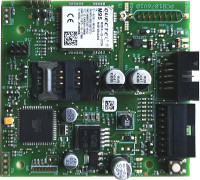Massimo Portolani, CEO of AlterCodex srl, started designing electronics
and software for telemetry devices in 1999, working in cooperation with italian telecom operator
Omnitel-Vodafone (for their Omnipay solution) and finnish operator Sonera.
Contact us for more information

Telemetry pcb
Early telemetry systems were GSM based, working either in CSD (Circuit Switched Data)
or IVR (a voice answers offering multiple choices, that can be chosen dialing numbers).
Starting 2004, GPRS networks were widely available and things became much easier.
With an average speed of 1 Kbytes per second, this is still the most used option for telemetry.
Now, in 2020, we are facing multiple options: they say GPRS will be dismissed and other options are available
or will soon be: like Nb-iot or Cat-M1. They are 3GPP standards and are designed to get well along
LTE and 5G. It seems they are the right technologies to use in the future. They have slightly different
features (better for meters the first one and for mobility the second), but both use little power, hence
can be powered with primary, not rechargeable, cells, that last for years. What will happen in most cases
is that products will be replaced at batteries end of life. An advantage of Nb-iot is that, thanks to redundancy,
it is able to penetrate sites normally not reacheable by GPRS.
Besides these SIM based approaches, there are other offers available, like LoraWan and SigFox
that offer 10 km ranges. For LoraWan it is possible to build a proprietary network, but licenses
are needed. For SigFox it is necessary to subscribe to an operator, so the approach is similar to the SIM based one.
We have used GPRS for years, we have designed units with Lora and we have recently designed
a Nb-iot device for soil moist monitors, that can be used for 2/3 years and then disposed of.
Among our customers for telemetry projects we are proud to include: Dedem Spa, leader in PhotoBooths and indoor Parks
and DMP Electronics, leader in electronic water taps.